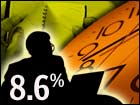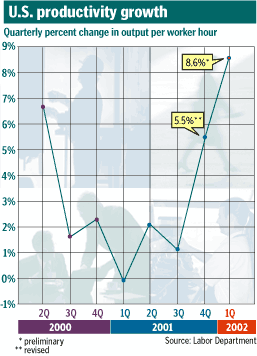
NEW YORK (CNN/Money) -
Investors have plenty of things to keep them up at night these days. They can fret over what the next accounting imbroglio will be, wonder what might get uncovered in the government's investigation into the brokers and worry about the volatile Middle East.
But one recent concern -- that even as the economy grows earnings will stay stuck in the doldrums -- should have been quashed by the report the government put out on productivity and labor costs on Tuesday.
The Labor Department said that nonfarm productivity -- a measure of how much the average worker produces in an hour -- grew by an annualized 8.6 percent in the first-quarter. A huge number, it's not just better than the 7 percent increase forecasters surveyed by Briefing.com expected, it's the biggest productivity boost the U.S. has seen since 1983. (For more, see "U.S. productivity soars.")
Meanwhile, because compensation costs grew only slightly, unit labor costs fell by 5.4 percent -- their biggest drop since 1983.
If you think of the U.S. economy as a big donut shop, Tuesday's report means that everybody is making donuts at a much faster clip, but only getting paid a little bit more for the effort. As a result the cost-per-donut has fallen sharply -- meaning that more of the cash the donut shop takes in is going to make it to the bottom line. Even if donut sales are flat, the donut shop's earnings are going to improve.
Which is a long way of saying U.S. corporate earnings are on the mend.
The market is playing 'wait and see'
That doesn't jibe with the market's view lately. One of the factors behind stocks' recent fall has been growing worries over a "profitless" recovery. After all, even though the economy grew at a 5.8 percent clip in the first quarter, the latest tally from Thomson Financial/First Call suggests that once all the company reports are in S&P 500 earnings will have slipped by 11.4 percent in the first quarter over the year-ago period.

"Right now the perception is we are not going to get the earnings recovery we thought we were going to get," said Jim Volk, co-director of institutional trading at D.A. Davidson. Indeed, since the first quarter GDP report came out in late April, the Dow Jones Industrial Average has shed 2 percent, while the Nasdaq has dropped 8.2 percent.
So why the disconnect between what the economists think and what the market's doing? Part of the problem is the way people look at the numbers. Gross domestic product (as well as the Tuesday's productivity and labor cost numbers) is measured from one quarter to the next.
But when they look at company profits, investors compare results to where they were a year ago. Salomon Smith Barney economist Steven Wieting reckons that a lot of investors are making an apples-to-oranges mistake, pairing the signs of economic recovery with the slip in year-over-year earnings and concluding the worst.
By his lights it didn't make sense that stocks were unable to hold onto most of their gains Tuesday, finishing the day roughly flat after a jump early on. "The reaction to this data in the past would have been much more positive," Wieting said. "These days only bad news is carrying weight."
But even the year-over-year numbers should start coming in better soon. Wieting estimates that S&P earnings will be up about 3 percent in the current, second quarter over the year-ago period, and that they'll tack on 15 percent in the third quarter.
"With many people fearing a profitless recovery, earnings will probably surprise to the upside," said Morgan Stanley chief U.S. economist Richard Berner. And just maybe the stock market's prospects aren't as bad as so many investors have come to think lately.

|

